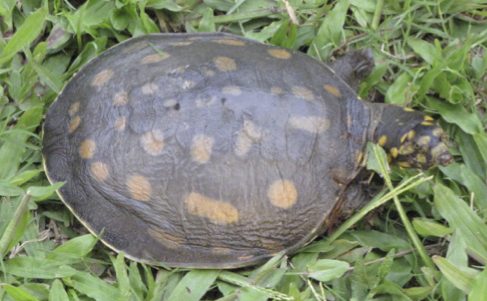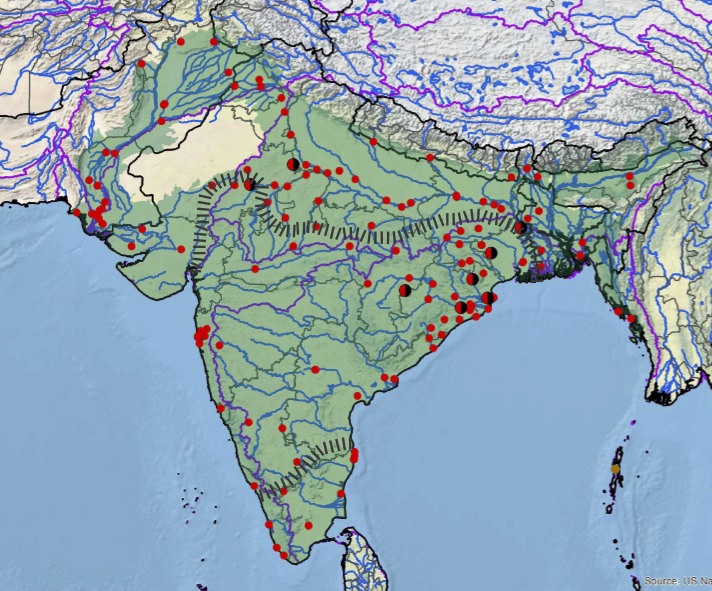Lissemys punctata, 076
Lissemys punctata (Bonnaterre 1789) –
Indian Flapshell Turtle
S. Bhupathy1, Robert G. Webb2, and Peter Praschag3
1Salim Ali Centre for Ornithology and Natural History,
Anaikatti (PO), Coimbatore, 641108 India [[email protected]];
2Department of Biological Sciences, The University of Texas at El Paso,
El Paso, Texas 79968 USA [[email protected]];
3Turtle Island, Puntigamerstrasse 7, 8041 Graz, Austria [[email protected]]
Summary. – The Indian Flapshell Turtle, Lissemys punctata (Family Trionychidae), is a relatively small softshell turtle with a carapace length of up to 350 mm. Three intergrading subspecies are confined to the Indian subregion. Individuals are adaptable and durable, occurring in a variety of aquatic habitats, ranging from rivers and streams to reservoirs, marshes, ponds, lakes, and even salt marshes, rice fields, gutters, and canals in metropolitan areas. It is common in brackish water lagoons on the east coast of India, and is often abundant in irrigation canals and tanks, and paddy fields with stagnant water. The species is not plentiful in the main channels of rivers or in large canals, but seems to prefer relatively shallow waters. Lissemys punctata is omnivorous and can survive periods of drought by estivating for a long time on land. Nesting generally occurs in late summer and extends into the monsoon season, July through November. Clutch size varies from 4–15 eggs, which generally have a prolonged incubation period of > 300 days. Despite extensive exploitation by man as a food source for many years, these turtles are still fairly common and seem to be holding their own, with populations relatively stable and not yet seriously threatened.
Distribution. – Bangladesh, India, Myanmar, Nepal, Pakistan. Distributed in the Indian subregion from the Indus basin of Pakistan through India, Nepal, and Bangladesh to northeast Inda and extreme western Myanmar. Populations on Sri Lanka formerly considered to belong to this species have recently been recognized as the distinct species L. ceylonensis.
Synonymy. – Testudo punctata Lacépède 1788 (nomen rejectum), Testudo punctata Bonnaterre 1789, Trionyx (Emyda) punctatus, Trionyx punctatus, Emyda punctata, Trionyx punctata, Lissemys punctata, Lissemys punctata punctata, Trionyx punctatus punctatus, Testudo sonnerati Meyer 1790, Testudo granulosa Suckow 1798, Testudo scabra Latreille in Sonnini and Latreille 1801, Testudo granosa Schoepff 1801, Trionyx granosus, Cryptopus granosus, Emyda granosa, Emyda granosa granosa, Lissemys punctata granosa, Trionyx punctatus granosus, Testudo granulata Daudin 1801, Trionyx coromandelicus Geoffroy Saint-Hilaire 1809, Emyda dura Anderson 1876.
Subspecies. – Currently three subspecies are recognized: 1) Lissemys punctata punctata (Southern Indian Flapshell Turtle) (distribution: southern peninsular India [Kerala, Tamil Nadu]); 2) Lissemys punctata andersoni (Spotted Northern Indian Flapshell Turtle) (synonymy: Lissemys punctata andersoni Webb 1980, Lissemys andersoni) (distribution: Bangladesh, northern India [Assam, Bihar, Haryana, Jammu, Madhya Pradesh, Meghalaya, Rajasthan, Sikkim, Uttar Pradesh, West Bengal], Myanmar, Nepal, Pakistan); and 3) Lissemys punctata vittata (Central Indian Flapshell Turtle) (synonymy: Emyda vittata Peters 1854, Emyda granosa vittata, Lissemys punctata vittata, Emyda granosa intermedia Annandale 1912) (distribution: central India [Andhra Pradesh, Chhattisgarh (?), Goa, Gujarat, Karnataka, Madhya Pradesh, Maharashtra, Orissa, Rajasthan]).
Status. – IUCN 2013 Red List: Least Concern (LC, assessed 2000); TFTSG Draft Red List: Least Concern (LC, assessed 2011); CITES: Appendix II; Indian Wildlife (Protection) Act, Schedule I; Bangladesh Wildlife Preservation (Amendment) Act (BWPA), Schedule II.
Citation:
Bhupathy, S., Webb, R.G, and Praschag, P. 2014. Lissemys punctata (Bonnaterre 1789) – Indian Flapshell Turtle. In: Rhodin, A.G.J., Pritchard, P.C.H., van Dijk, P.P., Saumure, R.A., Buhlmann, K.A., Iverson, J.B., and Mittermeier, R.A. (Eds.). Conservation Biology of Freshwater Turtles and Tortoises: A Compilation Project of the IUCN/SSC Tortoise and Freshwater Turtle Specialist Group. Chelonian Research Monographs No. 5, pp. 076.1–12, doi:10.3854/crm.5.076.punctata.v1.2014, //iucn-tftsg.org/cbftt/.
(Adobe Acrobat 6.0 or later required)

Adult Lissemys punctata punctata from Mamallapuram, Tamil Nadu, India.
Photo by Indraneil Das.

Adult male Lissemys punctata vittata, Mahanadi River, Orissa, India.
Photo by Shailendra Singh.

Juvenile Lissemys punctata andersoni, Assam, northeast India.
Photo by Chittaranjan Baruah.
Distribution:

Distribution of Lissemys punctata in Pakistan, India, Nepal, Bangladesh, and Myanmar in the Indian subregion of Asia. Purple lines = boundaries delimiting major watersheds (level 3 hydrologic unit compartments – HUCs); red dots = museum and literature occurrence records of native populations based on Iverson (1992), plus more recent and authors’ data; brown dot = occurrence record of presumed introduced population in the Andaman Islands; red/black dots = hybrid specimens of L. p. vittata x andersoni as determined genetically by Praschag et al. (2011); green shading = projected native distribution based on GIS-defined HUCs constructed around verified localities and then adding HUCs that connect known point localities in the same watershed or physiographic region, and similar habitats and elevations as verified HUCs (Buhlmann et al. 2009), and adjusted based on authors’ subsequent data; cross-hatched lines = approximate boundaries between the three subspecies as detemined genetically by Praschag et al. (2011), with L. p. punctata in the extreme south, L. p. andersoni in the north from southern Pakistan across northern India, Nepal, Bangladesh and western Myanmar, and L. p. vittata in central peninsular India, with a large and wide area of partial intergradation with L. p. andersoni in eastern India.








